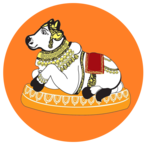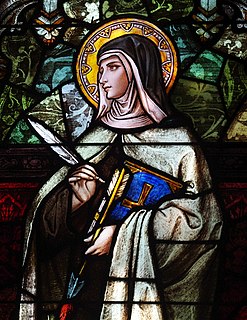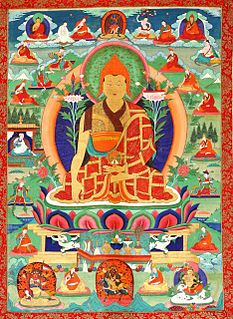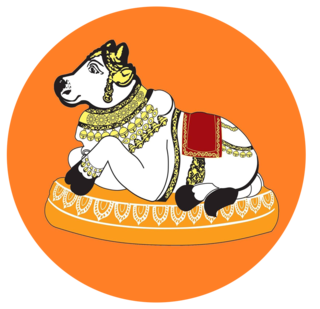
Bhaktapur, literally translates to Place of devotees. Also known as Khwopa, it is an ancient Newa city in the east corner of the Kathmandu Valley, Nepal, about 8 miles (13 km) from the capital city, Kathmandu. It is located in Bhaktapur District in the Bagmati Zone. It is administratively divided into 10 wards.
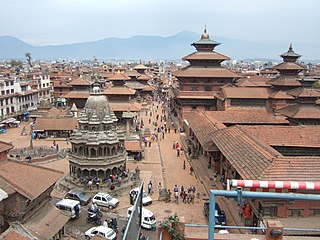
Lalitpur Metropolitan City, historically Patan, is the third largest city of Nepal after Kathmandu and Pokhara and it is located in the south-central part of Kathmandu Valley which is a new metropolitan city of Nepal. Lalitpur is also known as Manigal. It is best known for its rich cultural heritage, particularly its tradition of arts and crafts. It is called city of festival and feast, fine ancient art, making of metallic and stone carving statue. At the time of the 2011 Nepal census it had a population of 226,728 in 54,748 individual households. The city received extensive damage from an earthquake on 25 April 2015.

Nath, also called as Natha, are a Shaivist sub-tradition within Hinduism. A medieval movement, it combined ideas from Buddhism, Shaivism and Yoga traditions in India. The Naths have been a confederation of devotees who consider Adinatha, or Shiva, as their first lord or guru, with varying lists of additional lords. Of these, the 9th or 10th century Matsyendranath and the ideas and organization mainly developed by Gorakshanath are particularly important.Thus Gorakhnath was originator of "Nath Panth.

The Kathmandu Valley, historically known as Nepal Valley or Nepa Valley, lies at the crossroads of ancient civilizations of the Indian subcontinent and the broader Asian continent, and has at least 130 important monuments, including several pilgrimage sites for Hindus and Buddhists. There are seven World Heritage Sites within the valley.
The Malla Dynasty was the ruling dynasty of Kathmandu Valley from c. 1201–1779 CE on the Indian subcontinent. They have claimed Kshatriya status for themselves. The term Malla mean "wrestler" in Sanskrit. The first of the Malla kings came to power in Kathmandu Valley around 1200 CE. The Malla period was a golden one that stretched over 600 years, though it was peppered with fighting over the valuable trade routes to Tibet.

Yogi Gorakhnath was a Hindu yogi and saint who was the founder of the Nath tradition. He is considered as one of the two notable disciples of Matsyendranath. His followers are found in India at the place known as Garbhagiri which is in Ahmednagar in the state of Maharashtra. These followers are called yogis, Gorakhnathi, Darshani or Kanphata.
Alakh Niranjan is a term used by Nath Yogis as a synonym for Creator, and to describe the characteristics of God and the Self, known as the Atman. Alakh means "one which cannot be seen (perceived)" and niranjan means "spotfree". Niranjan is another name of Lord Shiva. Also spelled, "Alekh".

The Navanath, also spelt as Navnatha and Nao Nath in vernacular languages, are the nine saints, Masters or Naths on whom the Navnath Sampradaya, the lineage of the nine gurus is based. They are worshipped collectively as well as individually.

Madhyapur Thimi is a municipality in Bhaktapur District in the Bagmati Zone of central Nepal. Thimi lies between Kathmandu, Lalitpur and Bhaktapur in the Kathmandu Valley. It is one of the ancient, cultural and historical places along the trade route from Bhaktapur to Kathmandu. Like other old cities this city is also situated on elevated land and therefore one has to climb up to reach it. Thimi occupies an area of 11.47 square kilometres and is administratively divided into nine wards.

Bungamati, Newar Bunga, lies in Lalitpur Metropolitan Region in Lalitpur District, Nepal. Bungamati is a Newar village on a spur of land overlooking the Bagmati River

Sunakothi is a small town located about 4 km (2.5 mi) south of the main Lalitpur city in Lalitpur District. According to 2011 Nepal census, Sunakothi has a population of 10,092 living in 2397 individual households. Most of the people living in Sunakothi are Newar. The offshoot road near the Satdobato segment of the Ring Road leads to Sunakothi. This road ultimately leads to Lele and is referred to as Laxmi Prasad Devkota Marga .Thecho is situated on the southern part of Sunakothi, Bungamati and Bhaisipati on west, Dhapakhel on east and Khumaltar and Nakhipot on North.
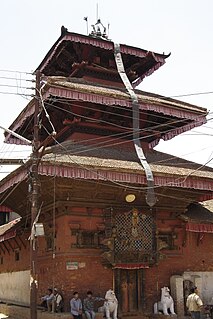
Lubhu is a village and former Village Development Committee that is now part of Mahalaxmi Municipality in Province No. 3 of central Nepal. Lubhu is a sub-urban Newar village situated seven kilometers east of Kathmandu in northern part of Lalitpur, Nepal.

Jāwalākhel is a subdivision of Lalitpur in Nepal. It is located 2 km from the ancient city centre Pātan, one of the three great capitals of Nepal until the 18th century. It derives its name from Jaulakhel Durbar, a palace located in Jawalakhel that was built by Bir Shumsher Jang Bahadur Rana in 1954 BS.
Rajopadhyaya is one of the five groups of Bramhan in Nepal. Witzel (1986) identifies the following five groups of Bramhans in Nepal, viz.
- the Newārī-speaking Rājopādhyāya Bramhans
- the Nepāli-speaking Kumāī Bramhans,
- the Nepāli-speaking Pūrbe Bramhans
- the Newārī-Maithilī-speaking Maithil Bramhans
- the Bhaṭṭa Bramhans from South India
Yogi Nath is a Shaivism-related group of monks which emerged around the 13th-century. They are sometimes called Jogi or simply Yogi, and are known for a variety of siddha yoga practices. Their tradition is known as Nath Sampradaya.

Jana Bahā Dyaḥ Jātrā is the chariot procession of Jana Baha Dyah, the Bodhisattva of compassion, which is held annually in Kathmandu. It begins on the 8th day and ends on the 10th day of the bright fortnight of Chaulā (चौला), the sixth month in the lunar Nepal Era calendar.

Seto Machindranath, also known as Janabaha Dyo, Avalokiteśvara, Karunamaya, Guanyin is a deity worshiped by both Hindus and Buddhists in Kathmandu. The temple of Seto Machindranath is located in Jana Bahal. Located at Keltole between Ason and Indra Chok in central Kathmandu, the temple is believed to have been established around the 10th century. Seto Machindranath is worshipped as an aspect of Avalokiteshvara.

Buṅga Dyaḥ Jātrā is a chariot procession honoring the Buddhist deity of compassion Avalokiteśvara held in Lalitpur, Nepal. It is one of the greatest religious events in the city and the longest chariot festival celebrated in the country.

Yogi Vilasnath ji Maharaj is a Guru of Natha Tradition, who is making efforts for the development and spreading of tradition in India and abroad. Yogi Vilasnath ji Maharaj is the main successor of Shri Baba Anandanath Maharaj who was a Mahamantri in Nath Tradition. In 2012 during the Great Ceremony of Shankhadhaal for his Guruji Anandanath Maharaj, Yogi Vilasnath ji was also appointed Mahant of Om Shiv Goraksha Panchayatan Mandir in Galane, Maharashtra. Yogi Vilasnath ji Maharaj is a member of "Akhil Bharatvarshiya Avadhut Bhesh Barah Panth Yogi Mahasabha", where he is engaged in the development and distribution of tradition. He is known in the Tradition owing to his extensive knowledge, his books and paintings. Yogi Vilasnath had been next to his Guru for over 20 years and has written many books on nath's practices. He is the author of Shri Nath Rahasya, Shri Goraksha Chalisa and Shri Natha Siddha Kawacha.

